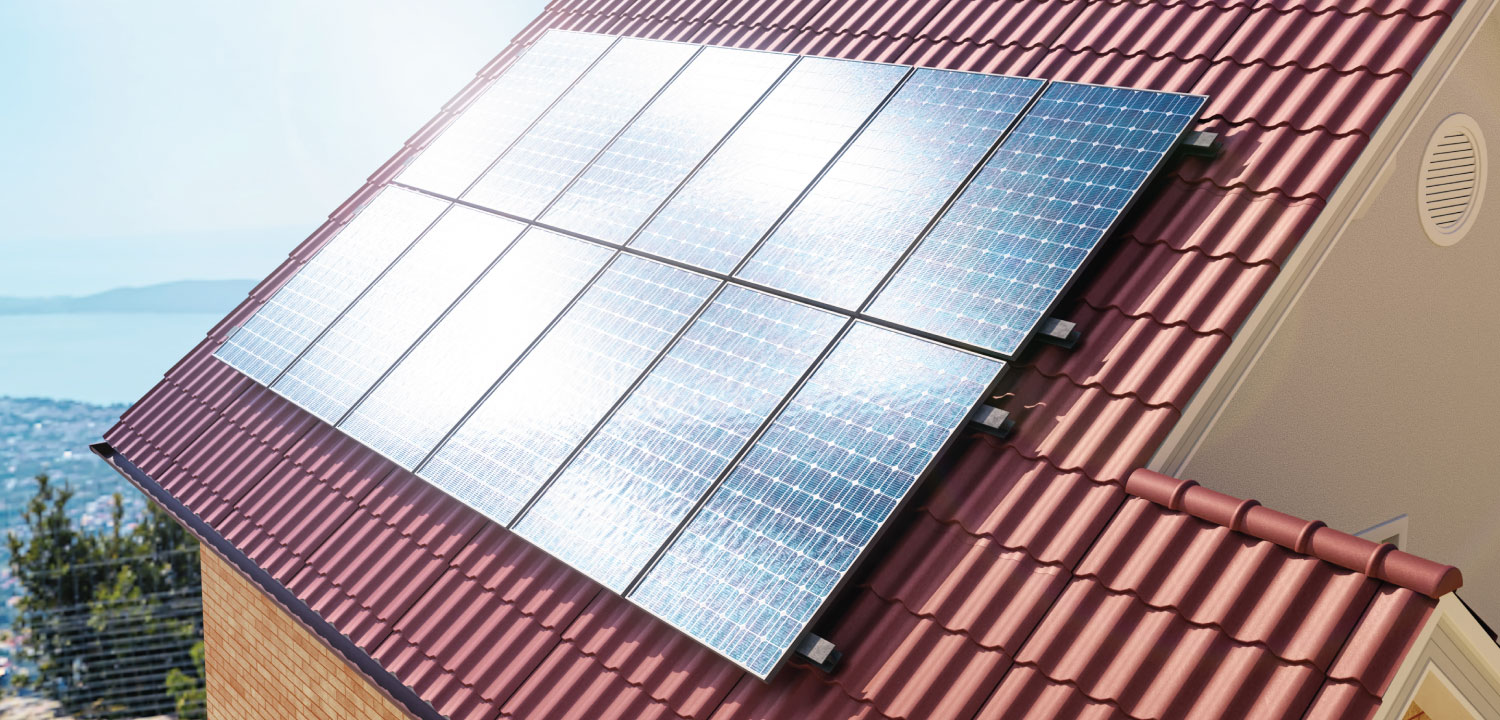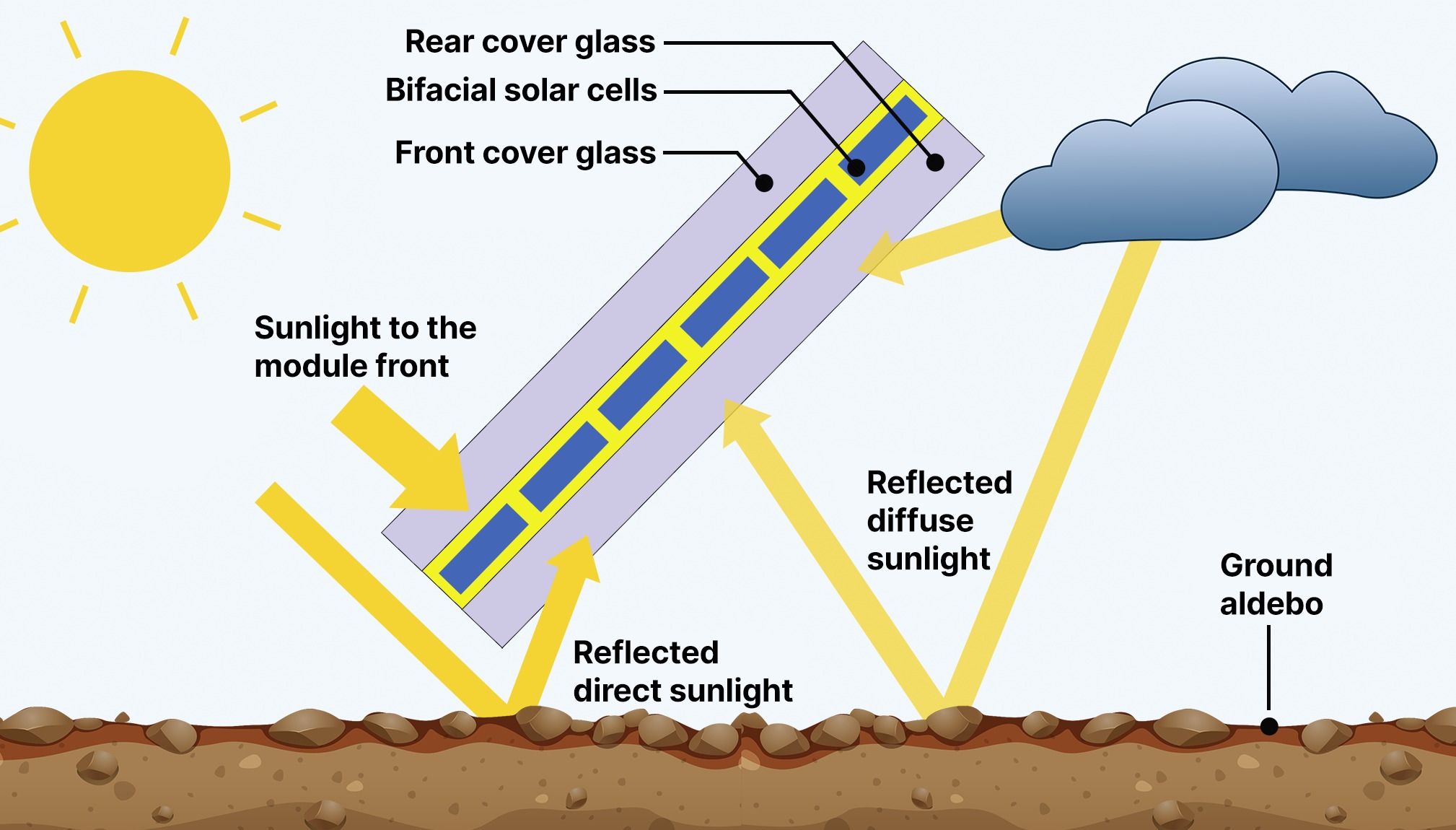Updated 10 months ago
Bifacial solar panels: innovative and more efficient
Written by
Jagpreet Sandhu

Find out what solar panels cost in your area
Bifacial solar panels have solar cells that absorb sunlight on the front and back of the panel. These panels do a great job of making the most out of the sun’s rays for longer periods, generating more power than traditional monofacial panels.
However, they aren’t a great choice for rooftop solar. Invest in bifacial solar panels for ground-mounted systems – or any other type of setup where the sun is guaranteed to hit both sides.
In this blog, we’ll take a closer look at the uses of bifacial solar panels, top manufacturers, and more.
Key takeaways
-
Bifacial solar panels can absorb sunlight from the back of the panel in addition to the top, making them ideal for applications where they are not bolted to a roof, like a utility-scale installation.
-
The top brands for bifacial production are Q CELLS, Canadian Solar, and Jinko Solar.
-
Bifacial solar panels are not practical for a home roof but they can be used on carports or pergolas.
On and off again: The tariff exemption on bifacial panels
Solar tariffs have caused a stir in the solar industry since former President Trump applied tariffs to solar panels manufactured outside of the United States. The intent of the tariffs was to help boost U.S. production and manufacturing, and thus the sale of U.S.-made solar panels.
This is a unique challenge though because putting tariffs on foreign panels means that there is less access to cheap solar panels. The Biden Administration kept many of the tariffs in place, but with some alterations. Importantly, bifacial panels remain exempt from the tariffs altogether, which is good news for utility-scale solar installers because they have access to globally manufactured solar panels.
The tariff timeline is as follows:
In 2018, bifacial solar panels were initially included when tariffs were imposed on solar panels
In 2019, they were granted an exemption by the Trump Administration
Late that same year, the Administration attempted to reinstate the tariff but was blocked by legal action from the solar industry
In November 2020, the U.S. Court of International Trade decided that the Administration could reimpose the tariffs on bifacial solar panels
In 2022, the Biden Administration extended the tariffs for an additional 4 years but exempted bifacial panels
Learn more: Top 5 American solar panel manufacturers
What exactly are bifacial solar panels and how do they work?
Bifacial solar panels have solar cells that absorb light from both the front side and the rear side of the panel. That means that instead of letting valuable light go to waste, the back of the panel is able to absorb it.

Sunlight can reflect from all sorts of non-reflective and reflective surfaces, even the ground. When sunlight bounces off of surfaces, say from light reflected from snow, this effect is called ‘albedo’. Bifacial solar panels can absorb this light and because of that, they provide increased efficiency and thus more energy generation than the traditional ‘monofacial’ solar panels that make up the vast majority of existing PV solar systems.
Here’s a quick video that demonstrates the idea behind bifacial solar panels:
Top bifacial solar panel manufacturers
Because they are still relatively new, bifacial panels are not produced by all solar panel manufacturers. LG was one of the top bifacial solar panel manufacturers, but they recently announced that they are leaving the solar panel business.
Stepping up in their place are the top bifacial solar panel manufacturers Q CELLS, Canadian Solar, and Jinko Solar.
Q CELLS
Q CELLS, one of the top-rated solar panels on SolarReviews, manufactures bifacial panels for utility-scale installations. The QPeak XL Duo has an efficiency rating of 21.4% and comes with a 12-year product warranty and a 25-year performance guarantee.
Q CELLS are one of the most popular brands for their performance and durability.
Canadian Solar
Canadian Solar has combined advanced bifacial cell technology with its double glass module manufacturing expertise to develop the ultramodern BiKu bifacial panels, which are used for utility-scale installations. Their highly durable racking frames are made with anodized aluminum alloy frames and 2mm of heat strengthened glass.
Canadian Solar claims that BiKu bifacial panels produce up to 30% additional power from the back side.
JinkoSolar
The Tiger model LM is the bifacial solar module offered by Jinko Solar. This module comes with a 13-year product warranty, 30-year linear power warranty, and claims a .45% degradation rate.
The unique frameless design of Jinko solar panels greatly reduces the possibility of the PID effect - a phenomenon that causes unwanted panel degradation.
While Q CELLS, Canadian Solar, and Jinko Solar are the best known, there are many other companies that manufacture bifacial modules. Here’s a list of other prominent market players who are involved in manufacturing advanced bifacial solar technology:
Check out our top-rated solar panel manufacturers for more.
Bifacial systems clearly have a promising future in the utility solar market. But what about when it comes to residential solar, are they a good fit for homes?
Are bifacial solar panels a good choice for homes?
Short answer: no.
The biggest reason for this is that bifacial solar panels don’t work well when installed on rooftops. Rooftop solar panels are mounted on frames which leave just a few inches between the panel and the roof surface. This means that very little reflected sunlight reaches the rear panel face, restricting bifacial solar production.
They require a large amount of space in order to avoid shading and to absorb the reflected light properly, making them less suitable for residential properties where real estate is limited.
Additionally, bifacial solar panels currently come with a significant cost premium, and in residential setups they are unlikely to produce the additional solar power required to justify their higher price. This means that traditional monocrystalline or polycrystalline solar panels are still the most cost-effective solar PV option for residential installations.
That being said, bifacial solar systems can still prove useful for certain residential applications. For instance, bifacial thin-film solar cells make sense when used for freestanding structures like carports, pergolas, or even solar trees - providing partial shade and producing energy from both sides.
Bifacial systems may also work for areas where there is no hindrance to the reflection of light. Canopies and awnings made from bifacial photovoltaics PV panels allow the reflected light to reach the back of the panels and generate additional sustainable energy for homes.
Major solar projects using bifacial solar technology
There are a number of large-scale solar projects built with bifacial solar modules that have been, and continue to be built.
These bifacial installations are an indication of how this technology has been booming globally. Here are some noteworthy developments:
In 2021, Robins Air Force Base in Georgia completed an 870 acre solar farm to provide power to the base
In 2021, the Taygete Energy Project in Pecos, Texas was under construction with 344 MW of solar power; it will be one of the largest solar projects in Texas
In 2019, LONGi began construction on a 224 MW capacity power generation project in Mitchell County, Georgia. It will be the largest "bifacial+tracker" power generation project in the United States
The bifacial solar panels market will take off but not all future panels will be double-sided
Bifacial solar panels are being hailed as solar energy's next big thing. With a higher rate of energy production, bifacial panels seem bound to become increasingly popular in the U.S. utility solar market.
However, like solar tracking systems, they are unlikely to have much of an impact on residential solar. A bifacial solar system mounted on the roof of a home can’t really capture the reflecting rays of the sun. Add to that their premium price and frameless design, and it’s clear that bifacial solar technology will not be a fit for most homes.
Jagpreet is a specialist in digital communication and creative writing. During her career, she has produced a wide range of content including blogs, articles, case studies, brochures, user manuals, and other creative assets. She has a keen interest in solar and envisions a bright future where all our energy comes from renewable resources. Jag has been an enthusiastic writer for more than seven years and is skilled in digital communication and cr...
Learn more about Jagpreet Sandhu